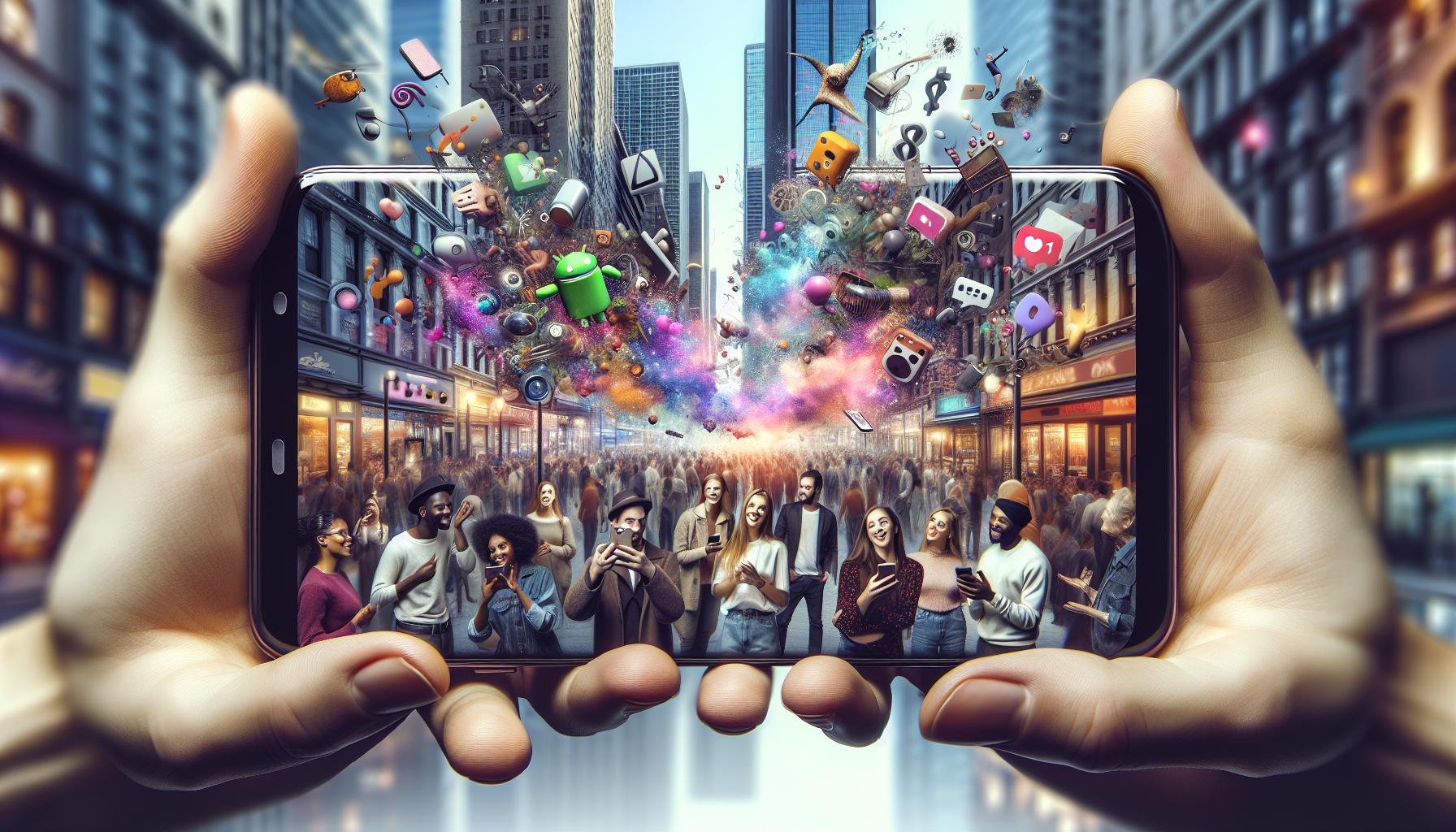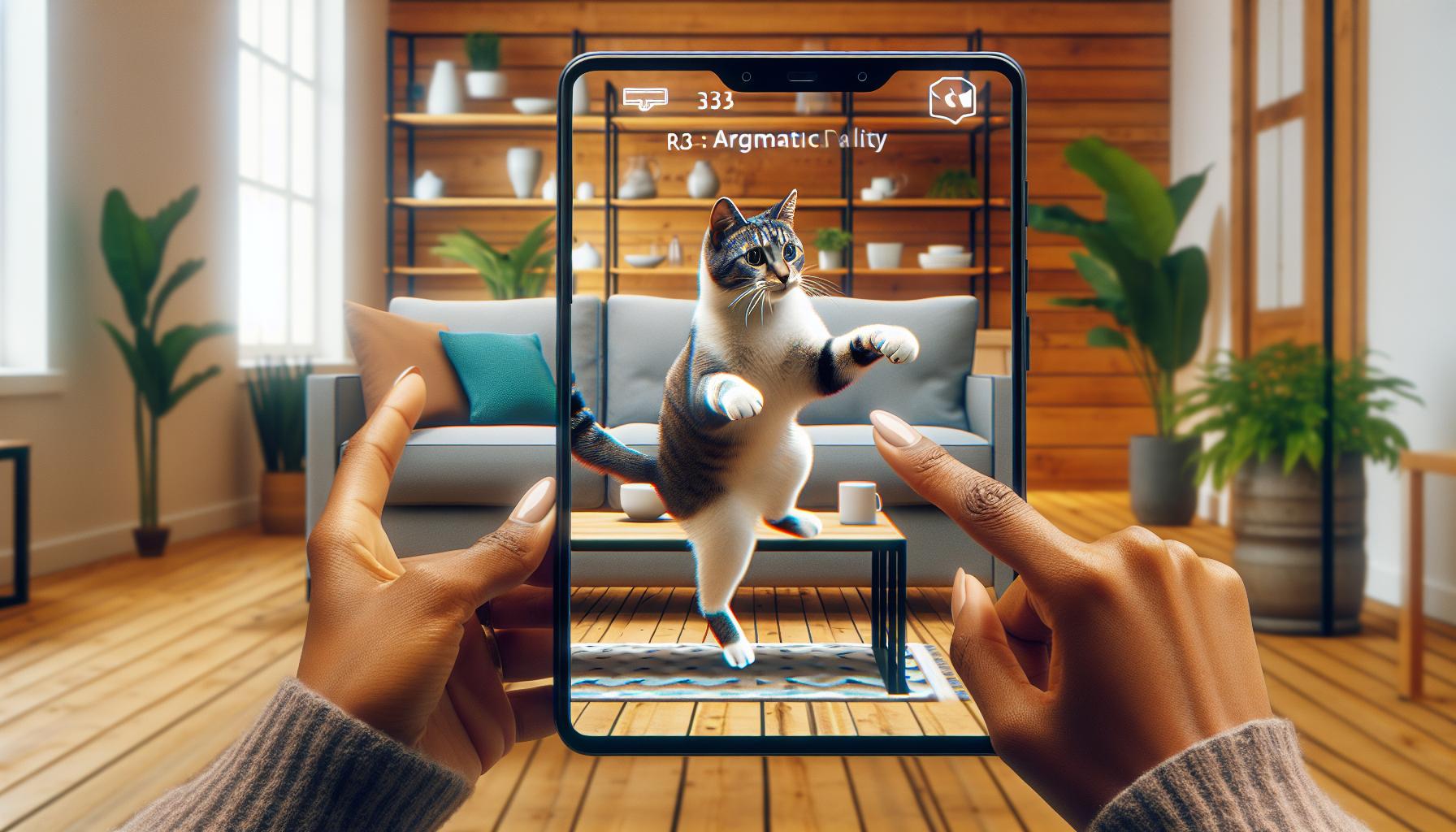Imagine scrolling through your social media feed and suddenly encountering a GIF that leaps off the screen, pulling you into a whimsical world where your cat wears a tiny top hat or your morning coffee dances a jig. That’s the magic of augmented reality GIFs. They blend the digital and physical realms in a way that’s not just cool but downright entertaining.
Augmented Reality GIF
Augmented reality (AR) enhances the real world by overlaying digital information. This technology allows users to interact with their environment in innovative ways.
Definition of Augmented Reality
Augmented reality refers to a technology that superimposes computer-generated images, sounds, or other data onto real-world environments. AR integrates digital elements with physical surroundings, creating interactive experiences. It differs from virtual reality which immerses users in completely digital environments. Applications often include gaming, education, and marketing, enabling users to visualize products or information in their physical context.
How Augmented Reality Works
Augmented reality operates through a combination of hardware and software. Devices such as smartphones and AR glasses use cameras and sensors to capture the environment. Software analyzes the captured data, identifying surfaces and relevant objects. Once identified, digital content is rendered in real-time onto the viewer’s screen. Technologies like GPS, accelerometers, and computer vision contribute to accurate placement and interaction with digital elements, enriching the user’s experience. This seamless integration enhances user engagement, making AR appealing across various fields.
The Role of GIFs in Digital Communication

GIFs play a significant role in digital communication, acting as a vibrant medium that enhances interaction. Digital users often prefer GIFs for their ability to convey emotions and ideas succinctly.
Evolution of GIFs
GIFs originated in 1987, initially serving as simple static images. Over time, the format evolved to support animation, allowing users to share short loops of action. By enabling rapid expression, GIFs transformed messaging platforms by adding a layer of fun and creativity. Major social media channels began supporting GIF integration, which further normalized their use in everyday communication. Now, GIFs serve as a unique language that transcends cultural barriers, enriching conversations in ways that text alone cannot.
Popularity and Usage of GIFs
A study revealed that nearly 71% of internet users regularly employ GIFs in their conversations. They enhance social media interactions, enriching posts and comments. Platforms like Twitter, Facebook, and Instagram have made GIFs easily accessible through built-in search tools. Users often browse libraries of GIFs to find the perfect visual representation for their sentiments. This widespread adoption demonstrates how GIFs effectively capture and communicate emotions, making them an essential part of modern digital dialogue.
Augmented Reality GIF: An Overview

Augmented reality GIFs combine the vibrant appeal of traditional GIFs with immersive AR technology. These digital creations enhance real-world environments by merging animated graphics seamlessly with physical spaces.
What Is an Augmented Reality GIF?
An augmented reality GIF serves as a type of animated image that integrates with the surrounding environment through AR technology. Users experience these GIFs by using smartphones or AR glasses to view animated elements overlaid onto their physical surroundings. The whimsical charm of a dancing cat, for example, comes to life as it interacts with real objects in the user’s space. This unique fusion of animation and reality allows for a new dimension of storytelling and entertainment.
Technological Innovations Behind Augmented Reality GIFs
Innovations in software and hardware drive the development of augmented reality GIFs. Advanced algorithms recognize real-world objects and surfaces, creating a framework for animations to interact realistically with their environment. Lightweight devices equipped with high-resolution cameras capture these surroundings, while AR software processes the data and renders the GIFs in real time. Continuous improvements in AR technology enable more complex and engaging experiences, pushing the boundaries of user interaction and creativity.
Applications of Augmented Reality GIFs

Augmented reality GIFs find applications across various domains, significantly enhancing user experiences and communication.
In Social Media
Social media platforms utilize augmented reality GIFs to elevate user interaction. These GIFs transform ordinary posts into engaging visuals, attracting attention. Users can share AR GIFs that superimpose animated elements onto their surroundings, enriching content. The playful nature of AR GIFs encourages users to express creativity. Platforms like Instagram and Snapchat already integrate these features, allowing for personalized experiences. Ultimately, AR GIFs contribute to the vibrant culture of social media, making interactions more dynamic and fun.
In Marketing and Advertising
Marketing strategies increasingly incorporate augmented reality GIFs to captivate audiences. Brands leverage the eye-catching nature of AR GIFs to create memorable advertisements. These GIFs allow consumers to visualize products in their environments, enhancing their connection to the brand. For instance, furniture retailers use AR GIFs to enable users to see how items fit in their homes before purchasing. This immersive approach significantly boosts engagement, leading to higher conversion rates. As marketers continue exploring AR technology, the impact on advertising will grow, proving its value in reaching targeted audiences.
Challenges and Limitations
Augmented reality GIFs present unique challenges and limitations that developers and users must navigate for optimal performance.
Technical Constraints
Complex algorithms are essential for detecting real-world environments and rendering digital content. Limited processing power in smartphones can hinder rendering quality, resulting in lag or inaccuracies. Device compatibility issues arise when different hardware fails to support the same AR features. Network connectivity also plays a critical role since slow internet speeds can disrupt real-time performance. Furthermore, inconsistencies in lighting conditions can affect the effectiveness of AR GIFs, resulting in a less immersive experience.
User Experience Issues
User experience remains a pivotal concern in augmented reality GIF adoption. Difficulty in accessing AR features may deter users from fully engaging. Confusion often arises when users do not understand how to interact with the augmented content. Additionally, physical space limitations, such as crowded environments, can restrict visibility and interaction. Users may face discomfort from extended use, as immersive experiences can lead to eye strain or dizziness. Use cases that lack intuitive design can make navigation frustrating, thus reducing overall satisfaction.
Augmented reality GIFs represent a fascinating intersection of technology and creativity. They transform everyday interactions into immersive experiences that captivate users and enhance communication. As this innovative medium continues to evolve, it offers exciting possibilities for social media engagement and marketing strategies.
Despite the challenges that come with implementing AR technology, the potential for user engagement remains significant. Brands and creators can leverage these dynamic visuals to connect with audiences in new ways. As AR technology advances, the future of augmented reality GIFs promises to be even more engaging and accessible, paving the way for a richer digital landscape.



